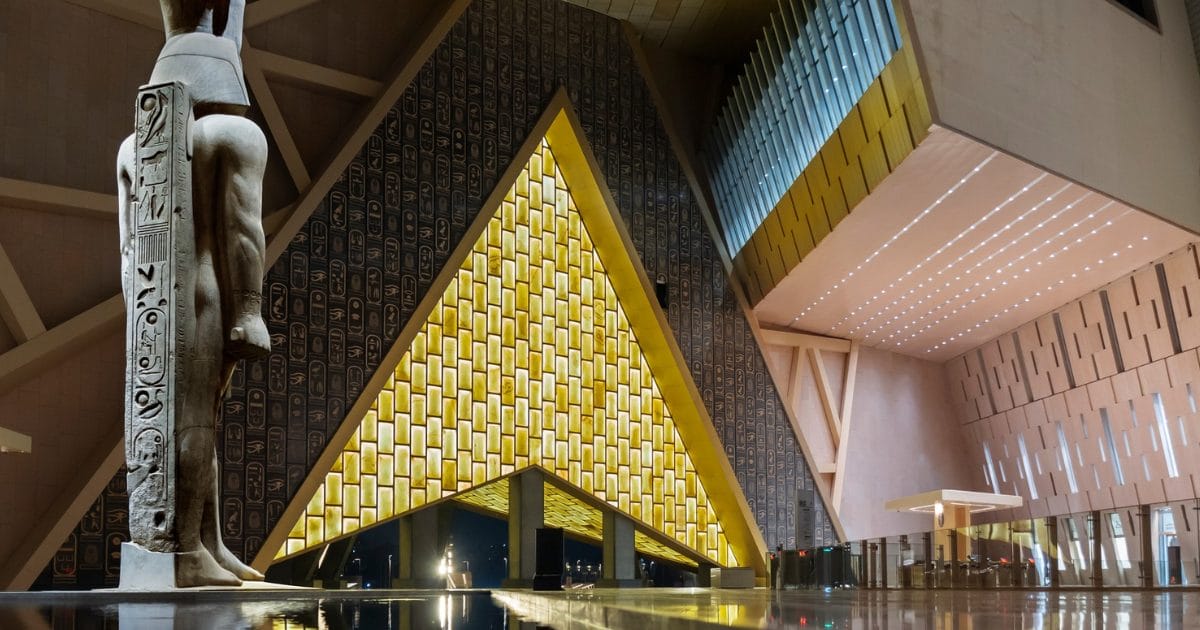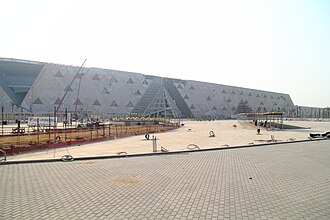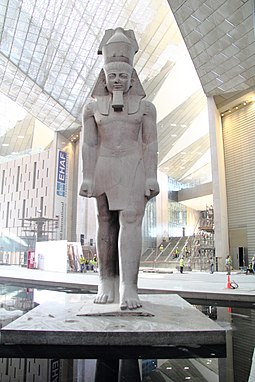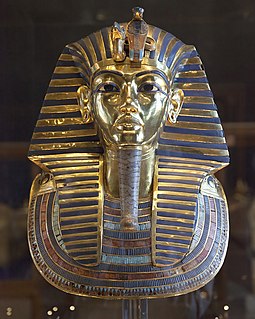

The Grand Egyptian Museum (GEM; Arabic: المتحف المصرى الكبير al-Matḥaf al-Maṣriyy al-Kabīr), also known as the Giza Museum, is an archaeological museum under construction in Giza, Egypt, about 2 kilometres (1.2 miles) from the Giza pyramid complex. The Museum will host over 100,000 artifacts from ancient Egyptian civilization, including the complete Tutankhamun collection, and many pieces will be displayed for the first time. With 81,000 m2 (872,000 sq ft) of floor space, it will be the world's largest archeological museum. It is being built as part of a new master plan for the Giza Plateau, known as "Giza 2030".

The GEM will also host permanent exhibition galleries, temporary exhibitions, special exhibitions, children museum, and virtual and large format screens with a total floor area of 32,000 m2.
The museum was built by a joint venture of the Belgian BESIX Group and the Egyptian Orascom Construction.
The original estimated completion date was 2013, and past estimates of the opening date have varied. In July 2023, the Minister of Tourism and Antiquities said that he "anticipates" the opening to be between October 2023 and February 2024.
| General information | |
|---|---|
| Type | Museum |
| Architectural style | Pharaonic (Egyptian) |
| Location | Giza, Greater Cairo |
| Country | Egypt |
| Construction started | 12 March 2012 |
| Completed | February 2023 |
| Opened | 6 February 2023 (limited access) |
| Cost | $1 billion |
| Client | Ministry of Antiquities |
| Technical details | |
| Floor area | 490,000 square metres (5,300,000 sq ft) |
| Website | |
| visit-gem.com | |
The building design was decided by an architectural competition announced on 7 January 2002. The organisers received 1,557 entries from 82 countries, making it the second largest architectural competition in history. In the second stage of the competition, 20 entries submitted additional information on their designs. Judging was complete by 2 June 2003. The competition was won by architects Róisín Heneghan and Shi-Fu Peng, and their company Heneghan Peng Architects of Ireland; the awarded prize was US$250,000. The building was designed by Heneghan Peng
Architects, Buro Happold, and Arup.
The landscape and site masterplan
was designed by West 8; the
exhibition masterplan,
exhibition design, and museology
was led by Atelier Brückner. On
2 February 2010, Hill International
announced that Egypt's Ministry
of Culture had signed a contract
with a joint venture of Hill and
EHAF Consulting Engineers to
provide project management
services during the design and
construction of the Grand Egyptian
Museum.

The building is shaped like a chamfered triangle in plan. It sits on a site 2 kilometres (1.2 miles) northwest of the pyramids, near a motorway interchange. The building's north and south walls line up directly with the Great Pyramid of Khufu and the Pyramid of Menkaure. The front of the museum includes a large plaza filled with date palms and a façade made of translucent alabaster stone. Inside the main entrance is a large atrium, where large statues will be exhibited.
On 5 January 2002, then-Egyptian President Hosni Mubarak laid the foundation stone of the Grand Egyptian Museum.
In 2006, the 3,200 years old Statue of Ramesses II was relocated from Ramses Square in Cairo to the Grand Egyptian Museum site, near that Giza Plateau. It was moved to the atrium of the museum in January 2018.

In January 2018, Besix and Orascom brought in and installed an 82-ton, 3,200-year-old statue of Ramses II in the Grand Egyptian Museum. It was the first artefact to be installed in the Museum, during construction, due to its size.
In May 2018, the last of King Tutankhamun's chariots was moved to GEM.
In November 2018, the estimate for a full opening was pushed back to last quarter of 2020, according to Tarek Tawfik, GEM's director. In April 2020, the planned opening of the museum was pushed to 2021 due to the COVID-19 pandemic. Various subsequent estimates ranged from 2020 to 2023.
In August 2020, two colossal statues discovered in the sunken city of Thonis-Heracleion by the IEASM were set up in the entrance hall of the GEM.
Although there has been no official announcement of an opening date, in July 2023, the Minister of Tourism and Antiquities said that he "anticipates" the opening to be between October 2023 and February 2024.
The GEM is available for private tours in advance of its official opening.

The exhibition will cover about one-third of the total museum grounds displaying c.18,000 artifacts (c.5000 objects in the Tutankhamun galleries, and c.13,000 objects in the other galleries) from the museum's total collections of c.50,000 objects. The main attraction will be the first exhibition of the full tomb collection of King Tutankhamun. The collection includes about 5,000 items in total and will be relocated from the Egyptian Museum in Cairo. Other objects will be relocated from storages and museums in Luxor, Minya, Sohag, Assiut, Beni Suef, Fayoum, the Delta, and Alexandria.
In August 2021 the reconstructed Khufu ship, a solar barque, was relocated to the Grand Egyptian Museum from the Giza Solar boat museum beside the Great Pyramid.
What You Can See During the Limited GEM Tours?
During the limited tour of the soft opening, everyone will cast their eyes on the following which include:
Conservation Centre.
Solar Boat of King Khufu
Hanging Obelisk.
King Ramses Il Statue.
10 Statues of King Senusert.
Grand staircase.
Statues of Ptolemaic King and Queen.
The Victory Column of King Mercnptah.
the Royal Regalia.
Grand Atrium & Gift shop.